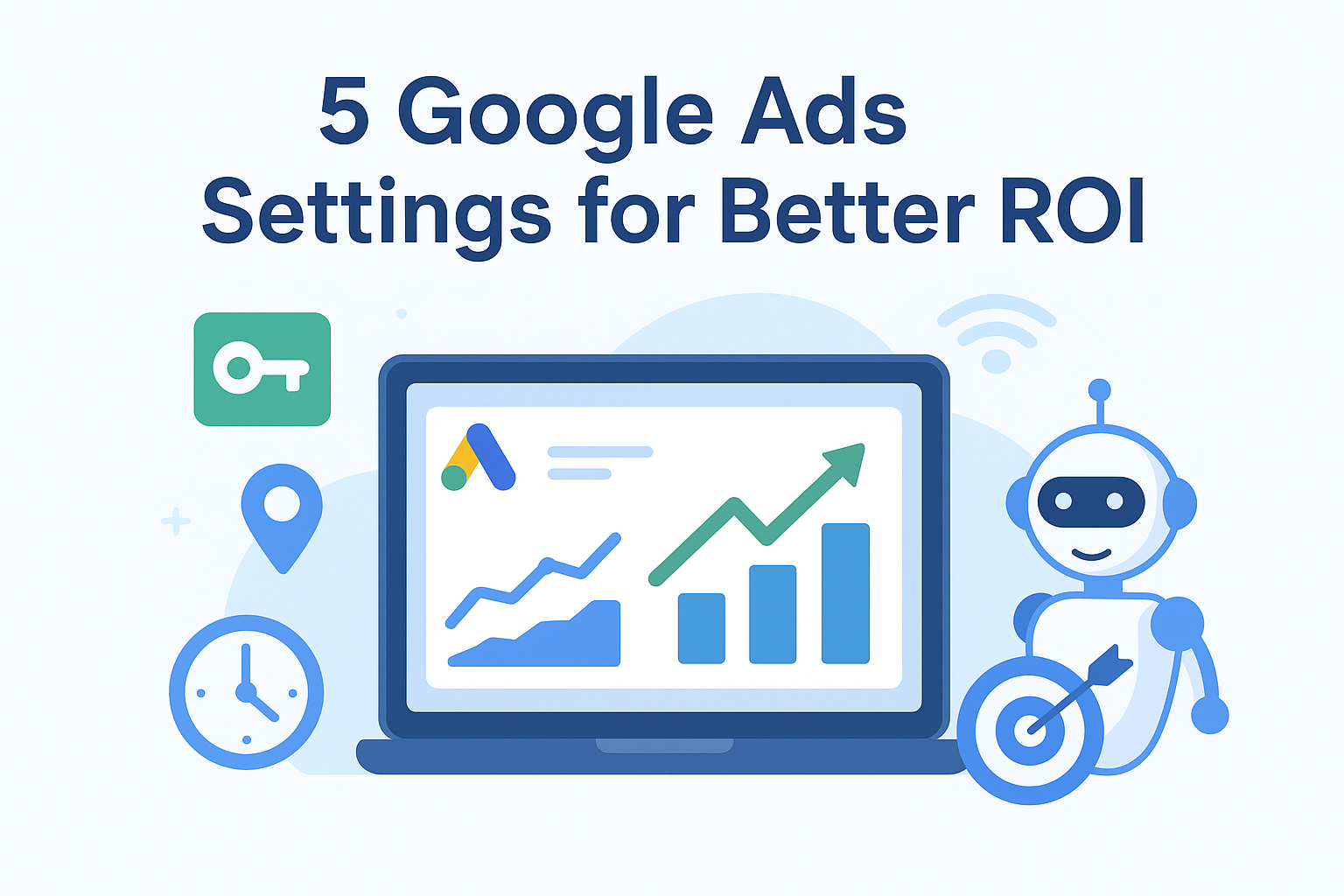Google Ads is one of the most powerful platforms for businesses looking to drive targeted traffic, generate leads, and maximise revenue. However, many advertisers struggle with high costs and low conversions simply because they don’t use the right settings. With billions of searches every day, the difference between wasted ad spend and strong ROI lies in how well you optimise your campaigns.
In this article, we’ll explore five crucial Google Ads settings that can significantly improve your return on investment (ROI). Whether you’re running campaigns for e-commerce, services, or local businesses, these strategies will help you lower costs, reach the right audience, and convert more clicks into customers.
- Refine Your Keyword Match Types
Keywords are the foundation of every Google Ads campaign. But if you’re not careful, you could be paying for irrelevant clicks that never convert.
Understanding Match Types
- Broad Match: Shows your ad to searches that are related, even if the keywords aren’t exact. This often leads to wasted spend.
- Phrase Match: Triggers ads for searches containing your keyword phrase, with words before or after.
- Exact Match: Only shows ads for searches that match the exact keyword (with some close variations).
Best Practices for ROI
- Use phrase match and exact match for your core keywords to ensure ads only appear for highly relevant searches.
- Combine this with negative keywords to filter out irrelevant traffic (e.g., if you sell luxury watches, add “cheap” or “free” as negatives).
- Continuously monitor the search terms report to identify keywords that are wasting budget and refine your list accordingly.
By tightening your match types and eliminating low-quality clicks, you ensure every rupee or dollar spent contributes toward genuine leads or sales.
- Optimize Location Targeting
Location targeting is one of the most overlooked settings in Google Ads. Too many businesses waste money by showing ads in areas they don’t serve—or worse, to people outside their geographic market.
Why It Matters
If you run a dental clinic in Mumbai, clicks from Delhi or London are useless. Similarly, if you only ship products within India, showing ads in other countries will drain your budget with zero ROI.
How to Optimize
- Set precise location targeting: Instead of targeting a whole country, target specific cities, regions, or even a custom radius around your business.
- Use location exclusions: Exclude areas you don’t serve to avoid wasted impressions.
- Leverage location bid adjustments: Increase bids for high-performing regions and reduce bids for underperforming ones.
- Target “Presence” not “Interest”: In campaign settings, select “People in or regularly in your targeted locations” rather than “People interested in”, which can bring irrelevant clicks.
Fine-tuning location targeting ensures you’re reaching the right people at the right place—boosting conversions while minimizing waste.
- Adjust Ad Scheduling (Dayparting)
Not all clicks are created equal. Your ads might perform better at certain times of day or days of the week. This is where ad scheduling (dayparting) comes into play.
Why Ad Scheduling Improves ROI
Running ads 24/7 means you’re paying for clicks even when your target audience isn’t active or ready to convert. For example, a B2B software company might see low conversions at midnight, while a local restaurant may get the best ROI during lunchtime or dinner hours.
How to Use It
- Analyze performance reports: In Google Ads, review the time of day and day of week reports to see when conversions happen most.
- Schedule ads for high-converting times: Run ads only during peak hours.
- Apply bid adjustments: Increase bids during profitable hours (e.g., +30% during evenings if more leads come then).
- Pause during low-value times: If late-night traffic brings clicks but no conversions, reduce bids or turn ads off during those hours.
By aligning your ads with customer behavior, you spend smarter and capture more conversions when buyers are most likely to act.
- Implement Smart Bidding Strategies
Bidding is at the heart of Google Ads ROI. Setting the wrong bidding strategy can either overspend your budget or underserve your campaign.
Manual vs. Smart Bidding
- Manual CPC: Gives full control but requires constant monitoring.
- Smart Bidding: Uses Google’s machine learning to adjust bids automatically based on conversion likelihood.
ROI-Focused Smart Bidding Options
- Target CPA (Cost Per Acquisition): Optimizes bids to get conversions at your desired cost. Great for lead generation.
- Target ROAS (Return on Ad Spend): Focuses on revenue-driven results, ideal for e-commerce.
- Maximize Conversions: Spends the budget to get the maximum number of conversions.
- Maximize Conversion Value: Prioritizes high-value transactions over just volume.
Best Practices
- Start with a conservative Target CPA to avoid overspending.
- Ensure you have enough conversion data (15–30 conversions in 30 days) for Smart Bidding to learn effectively.
- Regularly review performance and adjust targets as your business goals evolve.
Smart Bidding can dramatically improve ROI by aligning spend with outcomes rather than just clicks.
- Use Audience Targeting and Segmentation
Even with perfect keywords, not every searcher is ready to buy. Audience targeting helps you narrow down to people who are most likely to convert.
Audience Options in Google Ads
- In-Market Audiences: Users actively researching or considering products like yours.
- Remarketing Audiences: Visitors who interacted with your site but didn’t convert.
- Similar Audiences: People with similar behavior to your existing customers.
- Custom Segments: Tailored lists based on keywords, interests, or URLs.
How to Improve ROI with Audiences
- Layer audiences with keywords: For example, target “in-market for home loans” combined with your loan service keywords.
- Use remarketing campaigns: Show ads to past visitors with tailored messages (discounts, reminders, testimonials).
- Apply bid adjustments: Increase bids for high-value audiences (e.g., remarketing users) while lowering them for general traffic.
- Exclude low-value audiences: Prevent wasted spend by excluding demographics or interests unlikely to convert.
When you reach the right audience at the right stage of the buyer journey, you not only save money but also dramatically increase conversion rates.
Putting It All Together
Each of these five settings—keyword match types, location targeting, ad scheduling, bidding strategies, and audience segmentation—works best when used together. Here’s a quick action plan:
- Audit your keywords: Switch irrelevant broad match terms to phrase or exact, and add negatives weekly.
- Refine your geography: Tighten targeting to serviceable areas only.
- Schedule smartly: Run ads only when buyers are active.
- Adopt Smart Bidding: Let machine learning optimize for conversions while keeping a close eye on performance.
- Leverage audiences: Layer targeting and use remarketing to stay top of mind.
By following this structured approach, businesses can stop wasting ad spend, attract the right customers, and achieve a stronger ROI from Google Ads.
Google Ads is not just about getting clicks—it’s about getting the right clicks that lead to measurable results. Many advertisers fail because they set campaigns on autopilot and never fine-tune the settings. By applying the five strategies outlined above, you’ll gain more control over where your budget goes, who sees your ads, and how effectively those ads drive conversions.
Think of your Google Ads campaign like a high-performance car: without the right tuning, it won’t deliver the speed and efficiency you expect. With the right adjustments, however, you’ll reach your destination faster and with far less fuel wasted.
Start small, measure consistently, and refine over time. Your ROI will thank you.




